To have a better understanding of hybrid publishing, you have to understand that it’s basically traditional publishing but with a different revenue model and profit sharing formula.
Here, revenue is sourced from the sales of the author’s books and the fees publishers charge for the execution of their services. This is unlike the traditional method of publishing that only banks on the revenue generated from the sales of books.
Also, it can be simply defined as anything that is not self or traditional publishing. The author also keeps the major share of profits and they are not just subject to the sways of their publisher.
History of Hybrid Publishing
This category which goes as far back as the 1908 evolved as a result of the power it gives the author as they formed their book publishing project themselves and it has developed to allow print-on-demand (POD.) services by authors.
Also, crowdfunding initiatives for authors have also been developed in this category.
Here are some technical terms in the publishing industry that you should get familiar with.
Metadata: the data about the book (title author publisher and price)
Royalty: contractual agreements with the publisher that will contain what the sharing formula of proceeds from the sale of the book will be
Stitched Bind: books that have their folio stitched together and sewn to a cover
Dust Jacket: a removable outer cover that protects the book and it’s printed with the books cover design
Draft: the yet to be finalized version of a book
Hybrid Publishing (Pros)
1. More control for you
2. Ownership of book rights
3. High percentage of royalties
(Cons)
1. Require upfront payment
2. Not easy to find the choice for you guys
3. High financial risk
